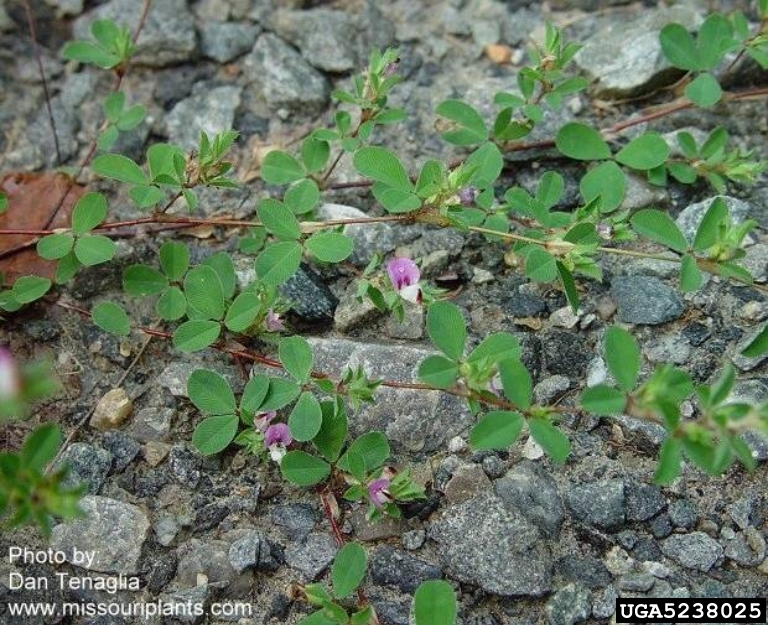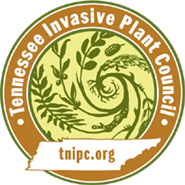Kummerowia stipulacea (Maxim.) Makino
Kummerowia stipulacea (Maxim.) MakinoKorean Clover, Korean Lespedeza
| Category |
|---|
| Forb/Herb |

Description
Stem
Multiple from base, from a taproot, erect to ascending or decumbent, herbaceous, purplish, branching, to 45cm long or tall, antrorse strigose (sometimes only in lines from beneath leaf petiole).Leaves
Alternate, petiolate, stipulate, trifoliolate. Stipules membranaceous, tan, drying quickly, ovate-lanceolate, striate-nerved, to +8mm long, 3-4mm broad at base, acuminate, glabrous, mostly entire but often with a few very minute teeth at the apex. Petiole green but with a red base, antrorse strigose, to +/-5mm long. Petiolules to 1mm long, reddish, antrorse pubescent. Leaflets obovate, to 15mm long, 8-9mm broad, mostly entire, truncate to rounded at the apex, mucronate, ciliate-margined, glabrous above, with a few cilia on midrib below, with distinctive striate venation.Flowers
Calyx green, bilabiate. Calyx tube to 2mm long, glabrous. Corolla’s lower 3 lobes rounded at apex, 1mm long,8mm broad. Upper lobe 1.1mm long and broad, slightly notched at apex, broadest at the apex. All lobes glabrous. Flowering July through October.Images
Photo: Dan Tenaglia, Missouriplants.com, Bugwood.orgMore images of Kummerowia stipulacea
Life History
Habitat
Dry open woods, waste places, roadsides, railroads.Origin and Distribution
Korean clover was first planted by the USDA in an experimental field in Arlington, Virginia, in 1919. The introduction(s) and early spread of Korean clover are less well documented than those of Japanese clover. Korean clover was not reported in a southeastern flora published by Small in 1933, but it was reported as "becoming abundantly established in many places" in Georgia in 1950. After its introduction, Korean clover was promoted for soil conservation and wildlife forage. Information collected from the University of Missouri's Extension Service showed that the acreage in Korean clover production increased by 33% from 1940 to 1941. Korean clover was common and abundant throughout Missouri by the late 1940s. Korean clover commonly escaped from hay fields and pastures and was widely seeded for wildlife habitat improvement.Korean Clover can be found in the following states: USA (AL, AR, DC, DE, FL, GA, IA, IL, IN, KS, KY, LA, MD, MI, MO, MS, NC, NE, NJ, NY, OH, OK, PA, SC, TN, TX, VA, WI, WV)
Synonyms
Lespedeza stipulacea Maxim.h2. Management Recommendations
Mechanical Controls
Cutting or mowing the clovers after the flowering stage may provide some control. In a crop production article, the authors reported that the clovers were still capable of setting seed after being cut at about the time of 1st bloom. In a review of cultivation materials, cutting clovers after flowering, cutting plants close to the ground, and cutting plants during drought conditions could lead to decreased abundance of the clover stands.Cultivation is not likely tolerated by the clovers. When annual plowing was compared at various times of the year in Tallahassee, Florida, Japanese clover did not occur in plots plowed in December, February, April, June, or August, although plants did occur on plots plowed annually in October
Herbicidal Controls
Very few studies (as of 2010) described in detail the effects of herbicides on clover populations. In Georgia, several herbicides and application timings were tested. In one trial, a single growing-season herbicide application provided good control (up to 99%) of Japanese clover within 2 years of its application in centipede grass, Eremochloa ophiuroides. Herbicides tested in March, before emergence of Japanese clover, provided little to no controlBiological Controls
Insect pests and diseases known to attack the clovers in the United States are identified and discussed in the following references.Biological control of invasive species has a long history that indicates many factors must be considered before using biological controls. Refer to these sources and the Weed control methods handbook for background information and important considerations for developing and implementing biological control programs.
Bibliography
Gucker, Corey L. 2010. Kummerowia stipulacea, K. striata. In: Fire Effects Information System, [Online]. U.S. Department of Agriculture, Forest Service, Rocky Mountain Research Station, Fire Sciences Laboratory (Producer). FEISChing-I Peng, Flora of Taiwan 2nd ed. 3: 314, 1993
